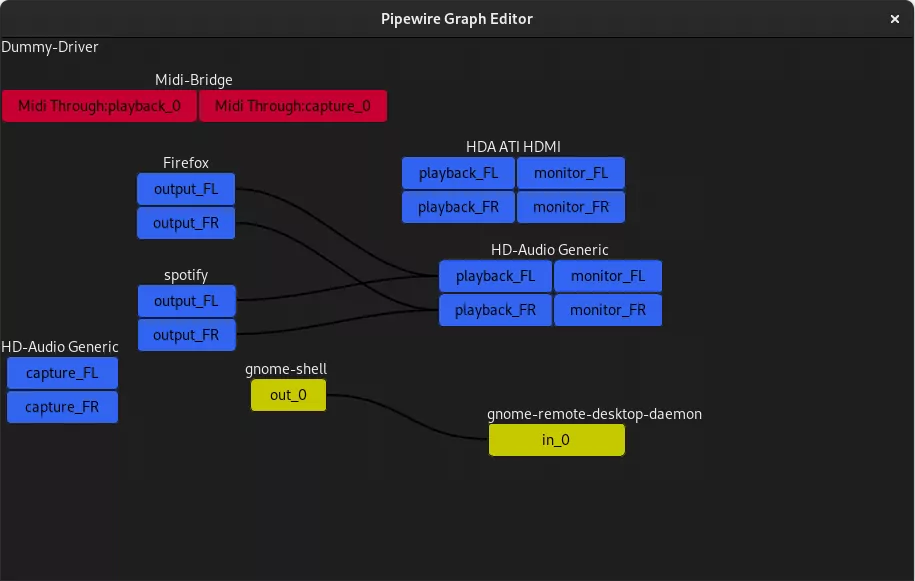Week highlights: new version of BeeRef available, Inkscape updates, VCV Rack 2 teaser, new PipeWire release, and more.
BeeRef 0.2.0
Rebecca Breu released a new version of BeeRef, an amazing free/libre reference image viewer. The main new feature is support for next notes (see my earlier post on the project).

G’MIC is getting new awesome filter
Paint with Brush is the latest addition to G’MIC. Even if you don’t understand German, just scroll to 1:45 to see it in action:
Inkscape updates
Most recently, Mike Kowalski merged his patch that turns the snapping toobar into a drop-down list of options (called popover in GTK).

Personally, I just save the usual snapping options I need into the default template, so I don’t particularly care how exactly they are accessible. What do you think?
In fact, Mike changed various part of the UI over the summer, e.g. you can now configure which parts of the status bar are visible by default. If you never use the drop-down list to navigate layers, you can disable it. And if you never use canvas rotation, you can lock canvas rotation and disable the status bar control over canvas rotation entirely. That gives you more space for context hints.

FreeCAD Trails add-on got its first release
Alright, that actually happened in July but I only noticed that today. Hakan Seven and Maarten Vroegindeweij made the first official release of Trails, the transportation engineering workbench for FreeCAD. And there’s new features coming all the time.
#FreeCAD #News Cool snapshot of progress on the #Trails workbench: '2D/3D PDOK data with 2D BGT with first quick and dirty version of 3D CityJSON'
— FreeCAD (CAD+CAM+FEA) (@FreeCADNews) September 12, 2021
+ basic documentation on how to use #GIS tools in Trails https://t.co/X4lFan3Dlc pic.twitter.com/kygRYJ5fNV
Olive allows previewing waveforms when dragging
Version 0.2 is slowly coming together. I know, it might sound silly, but I’m really glad to have this little feature brought back:
The git version of @OliveTeam now allows viewing the waveform while dragging an audio clip. It's the little things :) pic.twitter.com/mIvmisyn4L
— Libre Arts (@lgworld) September 8, 2021
VCV Rack 2 teaser
Andrew Belt released a preview of what’s coming in VCV Rack 2 now expected in November this year.
Highlights:
- Dark room mode (for working at night)
- Better module sections management
- Redesigned module browser
- VST2 plugin to be part of paid version, more options to be added
The bit you are probably most interested in, from a forum post:
VCV Rack Community Edition will be GPLv3 (free/open-source). VCV Rack Studio Edition will be $99 ($149 after release sale) and include VST2 plugin support (+more plugin formats later) and professional support.
And the important part for plugin developers:
90% of plugins will only require a version update and a recompile (a 1-line edit, 15 seconds of work). For the other 10% of plugins using advanced or unstable API features, updating to v2 is easy and involves following a few search-and-replace steps.
There’s a migration guide available: https://vcvrack.com/manual/Migrate2
PipeWire 0.3.35
There’s a new release of PipeWire every other week, here are some of the most (subjectively) interesting changes over the past few weeks:
- Support multiple sample rates in the graph
- S/PDIF pass-through over optical or HDMI is now implemented
- Bluetooth can now automatically switch between headset and audio profile
- Bluetooth codecs are now in separate plugins to make it easier to ship them
- Better JACK compatibility, including improved Catia and Carla compatibility
- Internal latency of ALSA devices can now be configured
- A fast convolver was added to the filter-chain to implement virtual surround sinks or reverbs
Meanwhile, you might want watching Helvum, a GTK-based patchbay for PipeWire.

ROLI files for bankruptcy, LV2 support in JUCE
If you didn’t follow all the news in the past few years, you might be asking yourself, whether ROLI filing for bankruptcy would affect JUCE in any way. After all, there are some very fine free/libre projects using this framework, like the recent DelayArchitect plugin.

Well, the thing is, they already sold JUCE to PACE in April 2020 (and probably started the process a year prior to that, as it is usual in mergers and acquisitions). And the project is rather active, they recently released version 6.1 with broader MIDI 2.0 support, support for VST3 extensions, support for native accessibility frameworks on macOS, Windows, iOS and Android etc. So no, unless you own any hardware instruments they made, you are probably fine.
Speaking of which, LV2 support might land to JUCE-based hosts and plugins after all. Developer reuk writes on GitHub:
We’ve recently been investigating adding LV2 support for both hosts and clients to JUCE, and I feel confident that this feature will be included in an upcoming release. We don’t have a concrete timeline for this work, but hopefully the beta will be ready soon (i.e. months rather than years).
Tutorials
Once you disregard the hilarious “Photoshop editing in GIMP” part of this video’s title, you might find this to be a very nice music-only tutorial on photo manipulation with GIMP.
This is a new Inkscape tutorial by grafikart:
Here is a great caracal speedpainting by Ali Bahabadi, made with Krita. The team recently published an interview with the artist:
This is a looooong no-commentary tutorial on making interior design visualization with Blender 2.9x and Eevee.
Featured Blender artwork: “The Greenhouse” by Laura Ganis.
Patreon subscribers get early access to my posts. If you are feeling generous, you can also make a one-time donation on BuyMeACoffee.

